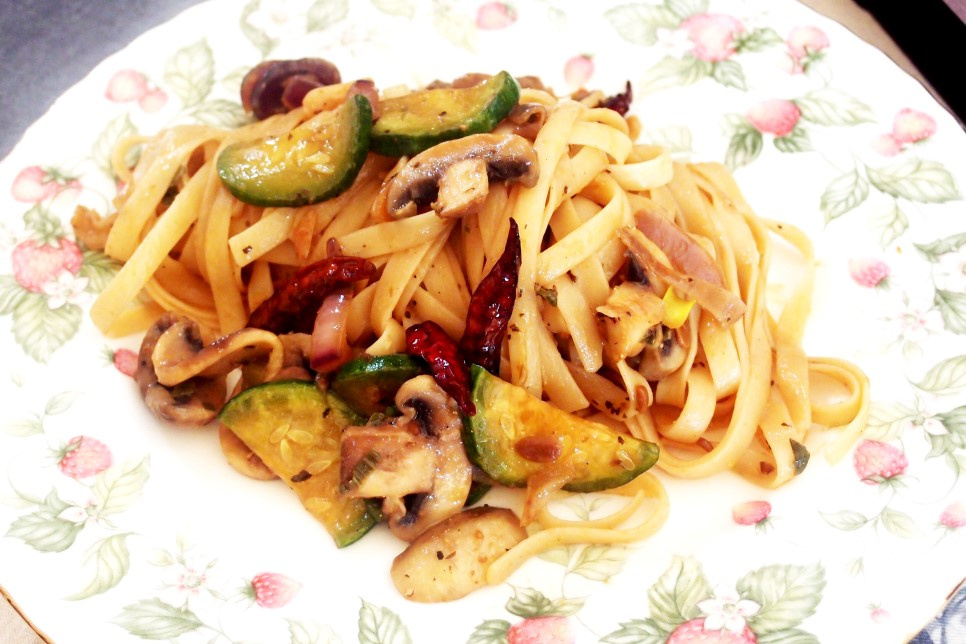Savory & Spicy Doenjang Fettuccine Pasta
#Christmas #YearEndParty #HowToMakeDoenjangPasta #UniqueDoenjangPasta #SpicyAndSavoryDoenjangPasta!!!

Discover a unique pasta recipe featuring ‘Tojang,’ a rich, traditional Korean soybean paste. Tojang is essentially unrefined doenjang, made without separating the soy sauce, offering a deeper, more complex savory flavor that was once favored by nobility. This recipe harmonizes the robust essence of tojang with the natural sweetness of zucchini and onions, complemented by a subtle kick from chili peppers. To ensure a perfectly balanced taste, a touch of honey is added to mellow any potential pungency of the tojang. Served with broad fettuccine noodles that beautifully capture the sauce, this distinctive Tojang pasta is a delightful departure from conventional cream or tomato-based dishes. It’s an ideal, conversation-starting dish for your Christmas or New Year’s Eve celebrations, offering a novel yet comforting taste of Korean culinary heritage.
Ingredients- 2 Tbsp Tojang (fermented soybean paste; homemade or regular doenjang can be substituted)
- 2 servings Fettuccine pasta
- 3 Shiitake mushrooms
- 1/4 Zucchini
- 1/2 Onion
- 2 Tbsp minced garlic (or sliced garlic)
- 4 Tbsp Olive oil
- 2 Tbsp Honey
- 1 tsp Salt (for seasoning adjustment)
- 1 Tbsp Dried herbs (e.g., rosemary, thyme)
- 4 Dried bird’s eye chilies (or substitute with fresh chili peppers, adjust to taste)
- 2 Tbsp Chopped green onions
Cooking Instructions
Step 1
Begin by preparing your vegetables. Slice the shiitake mushrooms thinly and shred the onion. Cut the zucchini into half-moon shapes for a tender bite. For this recipe, we’re using fettuccine, whose broad surface is perfect for clinging to the rich sauce. Also, prepare the honey, which will help balance the deep flavor of the tojang. While tojang is ideal, you can substitute with homemade or store-bought doenjang, but tojang adds a distinct depth.

Step 2
Heat 4 tablespoons of olive oil in a pan over medium-low heat. Add the sliced garlic and sauté gently until fragrant and lightly golden. Be careful not to burn the garlic, as this will impart a bitter taste. Infusing the oil with garlic aroma is key to a flavorful pasta.

Step 3
To temper the potent flavor of the tojang, stir in 2 tablespoons of honey and mix well. The honey will help round out the savory and umami notes of the paste, creating a more harmonious taste profile.

Step 4
Once the garlic is fragrant, add the chopped green onions and dried bird’s eye chilies to the pan. Sauté them together. The chilies will lend a pleasant, spicy kick to the pasta, cutting through the richness and adding a distinctly Korean touch. Feel free to add more chilies if you prefer a spicier dish.

Step 5
After the aromatic base is developed, add the prepared zucchini, onion, and shiitake mushrooms to the pan. Sauté them in olive oil over medium heat until they are tender and slightly translucent. Stir-frying brings out their natural sweetness.

Step 6
When the vegetables are starting to soften, sprinkle in 1 tablespoon of dried herbs for an aromatic lift. At this stage, you don’t need to add salt or pepper. The tojang is already salty and flavorful, so we’ll adjust the seasoning later using the tojang sauce and pasta water.

Step 7
Now, add 2 tablespoons of tojang to the pan. Stir and sauté everything together until the tojang is well combined with the vegetables and oil. This step deepens the savory flavor of the tojang sauce.

Step 8
In a separate pot, bring a generous amount of water to a rolling boil. Add 1 teaspoon of salt. Once boiling, add the fettuccine pasta. Use chopsticks or a pasta fork to stir occasionally and prevent the noodles from sticking together. Cook the pasta until it’s al dente, typically 1-2 minutes less than the package instructions suggest. Before draining, reserve about 2 ladles of the starchy pasta water. This water is crucial for emulsifying the sauce and achieving the perfect consistency.

Step 9
Drain the cooked pasta and immediately transfer it to the pan with the tojang sauce. Pour in about 2 ladles of the reserved pasta water. The starch in the water will help the sauce cling beautifully to the noodles and create a smooth, creamy texture.

Step 10
Toss the pasta and sauce together vigorously using tongs or a spatula to ensure every strand is coated. If the pasta seems too thick or dry, add a little more olive oil or a splash more pasta water until you reach your desired consistency.

Step 11
Continue to stir-fry the pasta and sauce until everything is well combined and the appealing color of the doenjang sauce develops. Taste and adjust the seasoning if needed. You can add a tiny bit more tojang or use salt if it’s not salty enough, but often the tojang alone provides sufficient saltiness.

Step 12
Now, for plating. Use chopsticks or a fork to twirl the pasta into neat portions and place it on your serving plate. This presentation adds a touch of elegance.

Step 13
Finally, spoon the sautéed vegetables (zucchini, mushrooms, onions) from the pan over the pasta. Voilà! Your unique and flavorful Tojang Fettuccine Pasta is ready. It’s a perfect, distinctive dish for Christmas parties or year-end gatherings. Enjoy this delightful taste of Korea!




